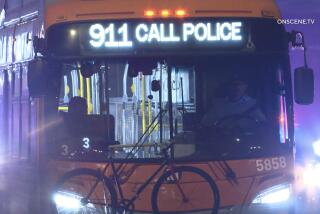Misery Rules in the City’s Strike Zone : Transit: Without bus service, commuters are inconvenienced by the thousands. But bandit cabbies find a silver lining.
Last week’s transit strike inconvenienced hundreds of thousands of commuters last week but put a smile on the face of Sixto Gutierrez, whose unlicensed transportation business was thriving.
“Fifteen, 20 people fit in here,” said Gutierrez, 32, in the driver’s seat of his Chevy van as it pulled up to the corner of 6th and Alvarado streets. Charging his passengers $2 or $3 apiece, Gutierrez said he was clearing $100 to $150 per day.
Los Angeles’ first transit strike in more than a decade began Monday when 1,900 of the Metropolitan Transportation Authority’s mechanics walked off the job in a dispute with management over subcontracted work. About 5,000 bus and train drivers and clerks honored picket lines.
With only about 300 of the usual 1,900 buses running along 30 of 200 routes, many riders found themselves stranded and in need of alternate travel plans.
*
Fares last week were reduced to 50 cents on MTA buses and the Blue Line, with no fee on the school buses that the MTA rented to provide auxiliary service. Red Line fares were 25 cents.
Gutierrez and his colleagues operating bandit taxis and vans converged on MacArthur Park, teeming with commuters stranded at the terminus of the Red Line subway that has been running despite the bus strike.
Said the driver of an unmarked yellow car who declined to identify himself: “We’re cheaper than the regular taxis. And now the police aren’t bothering us because we’re providing a genuine service.”
The driver added that instead of making his usual $40 a day, he’s cleared more than $100 each day since the strike began Monday.
But happy entrepreneurs were in the minority.
Virginia Ortiz, a sidewalk vendor in the MacArthur Park area who sells hot dogs wrapped with bacon and smothered with onions, said the strike has forced her to spend more money to get between work and home. She said unmarked cab operators had charged her $5 to $7 for a bus ride that would regularly cost $1.35.
Candida Romero, who runs a magazine stand, said her business suffered last week. Normally, she said, sales are robust because of her location near a bus stop at Wilshire Boulevard and Alvarado Street. With the disappearance of many loyal customers, she said, sales are going nowhere. Romero, who depends on the bus herself, said she has had to walk to and from work, a two-mile trip. “I’m afraid since it’s not safe for a woman to walk home alone in this city,” she said.
More fortunate bus riders were able to fit the functioning Metro Red and Blue lines into their commutes.
The Blue Line light rail and the Red Line subway ran an abbreviated schedule all week, with many passengers finding the bus line connections running late or not at all. Trains bulged with extra passengers; MTA officials said ridership was up but couldn’t estimate the increase.
For Liliana Guzman, who works at a Downtown clothing assembly factory, the strike put a heavier burden on her and co-workers who did make it to work Monday: “I had to do other people’s work, since the 16 of us who showed up today had to do the work of 50. Things went pretty slow.”
Unable to get a bus, the 28-year-old Compton woman said she walked about two miles from home to the Blue Line station for her commute into Downtown, but arrived late for work.
Mirna Salazar, a mother of four, missed her 3-year-old’s appointment at the San Judas Medical Group on Wilshire Boulevard. Salazar, who lives in Los Angeles, said she waited 3 1/2 hours for bus service before deciding to take the Blue Line.
She arrived at the clinic late, only to find that her daughter’s appointment had already been rescheduled; she’d have to come back another day.
Salazar, who said that caring for her daughter keeps her from working, can’t afford a car. “It’s hard enough not having a car in times of emergency,” she said. “With this strike, (commuting) will probably get worse.”
Gi Gi Jimenez, a receptionist at San Judas Medical Group, where Salazar’s daughter, Angeles, went for care, said the low-income clinic experienced a large drop in patients because of the MTA strike. San Judas usually receives about 150 patients a day, Jimenez said, but Monday that number fell to well below 100. Many of San Judas’ patients depend on public transportation, she said.
More to Read
Sign up for Essential California
The most important California stories and recommendations in your inbox every morning.
You may occasionally receive promotional content from the Los Angeles Times.










